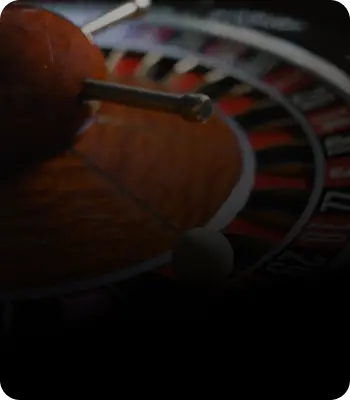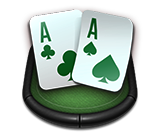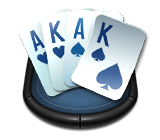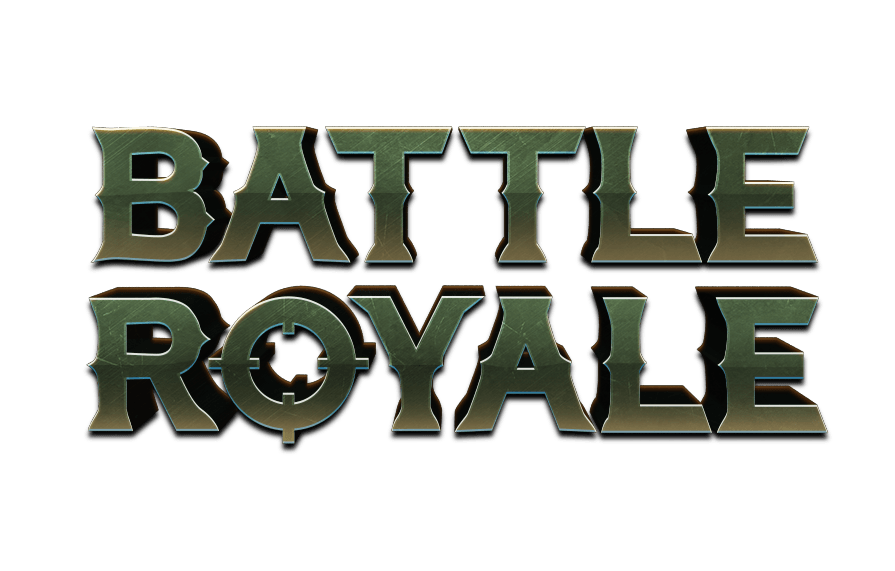
Today we’re going to discuss the push-fold strategy. This technique is also referred to as shove-fold. But what exactly does it mean? And when would be the right time to employ these tactics? Read on to find out.
In this article, we’ll discuss the push-fold strategy. Understanding when shove-folding is appropriate and why is a key component of the game.
What Is The Push-Fold Strategy?
Push-fold, or shove-fold, is a crucial element of poker tournament strategy that all players should familiarise themselves with. It is a strategy that comes into play when you’re low on chips. It doesn’t really apply in cash games, since you can simply pay to top up your stack.
Essentially, it requires a shift in mindset to an “all or nothing” approach. That may appear reckless, but it’s not. In this article, we’ll explain the logic behind it and how to use push-fold effectively.
It is most commonly employed in faster-paced tournaments such as Turbo Sit and Gos, where blinds rise quickly. But even in a deep stack event, if you find yourself short in chips, push-fold could come into play.
Why Push-Fold At All?
First of all, with so few chips to work with, you have little room to manoeuvre. You can’t peel off a speculative flop and then fold when you don’t connect. You can’t splash around and try to make clever plays. The shorter that stack is, the more precious each chip becomes. So it’s not only crucial to preserve chips to stay in the game, but you must maximise their value when betting.
Additionally, if you reduce your available options, you also eliminate opportunities to overthink and make errors. This is especially true if you’re a newcomer to tournament poker. Life just becomes much simpler when your only decision is between shoving and folding. By cutting your possible moves to just two, you’re going to be in the best shape to recover your starting stack.
Why Not Just Raise?
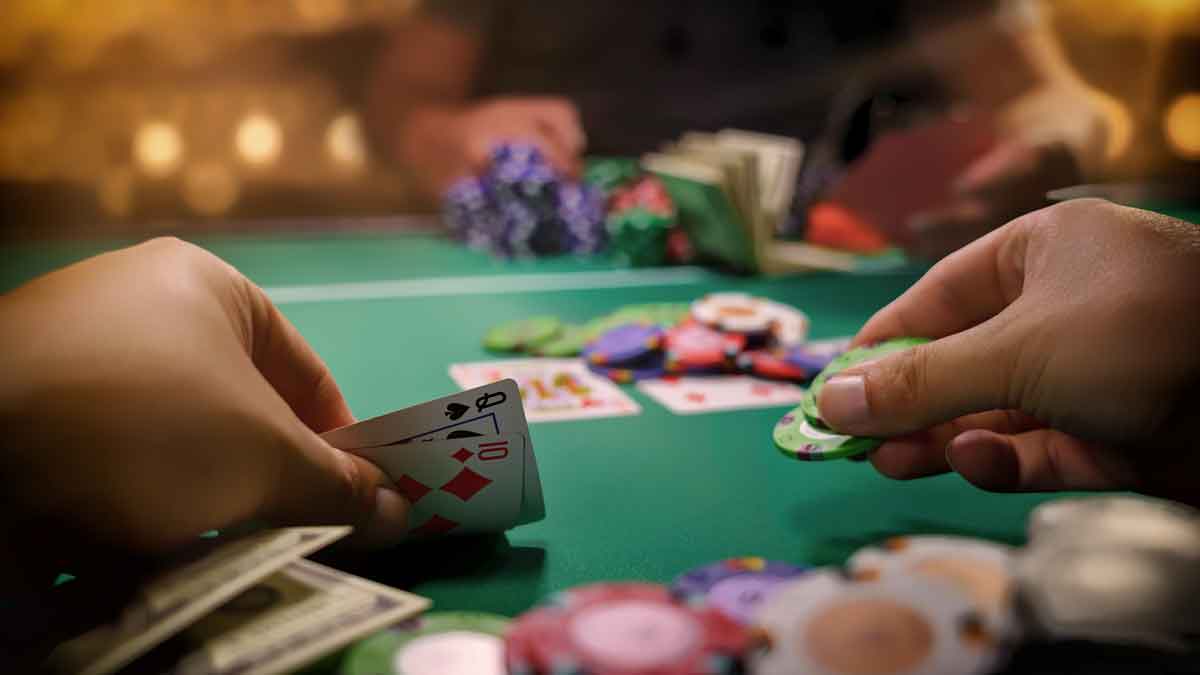 Surely risking your entire stack is crazy? You could be eliminated if you are called. It’s true, but an all-in is better than a raise for several reasons. Take this situation. You have eight big blinds left and look down at 9♥️-8♥️. If you make a standard raise of around 3x BB, you’ll likely find a caller or two.
Surely risking your entire stack is crazy? You could be eliminated if you are called. It’s true, but an all-in is better than a raise for several reasons. Take this situation. You have eight big blinds left and look down at 9♥️-8♥️. If you make a standard raise of around 3x BB, you’ll likely find a caller or two.
What happens when the flop comes A♣️-K♣️-7♣️? There are straights, flushes, and overcards everywhere. How can you continue? Betting is dangerous and calling a bet is suicidal as you don’t have any kind of a draw. But what if you’d gone all-in preflop?
Is anyone going to call an 8x BB raise? They probably would if they had A-A or K-K, but with anything else, you’re likely to pick up the blinds and drag your chip stack back towards good health. If you do find a caller, you can’t be outplayed in the hand. You can’t be forced into a fold. You’ll always have some kind of equity and you are guaranteed to see the river card.
Playing Push-Fold Strategy Properly
If push-folding makes life so much easier, why don’t all players just employ this strategy the entire time? Well, like much in the poker world, it’s a little more complicated than that.
Taking a push-fold approach relies on luck since your tournament life is at stake whenever you are called after a shove. To use this method properly, you need to understand exactly when it’s effective to do so. And that time is when you are short-stacked. But what exactly does it mean to be short-stacked?
Understanding Stack Size
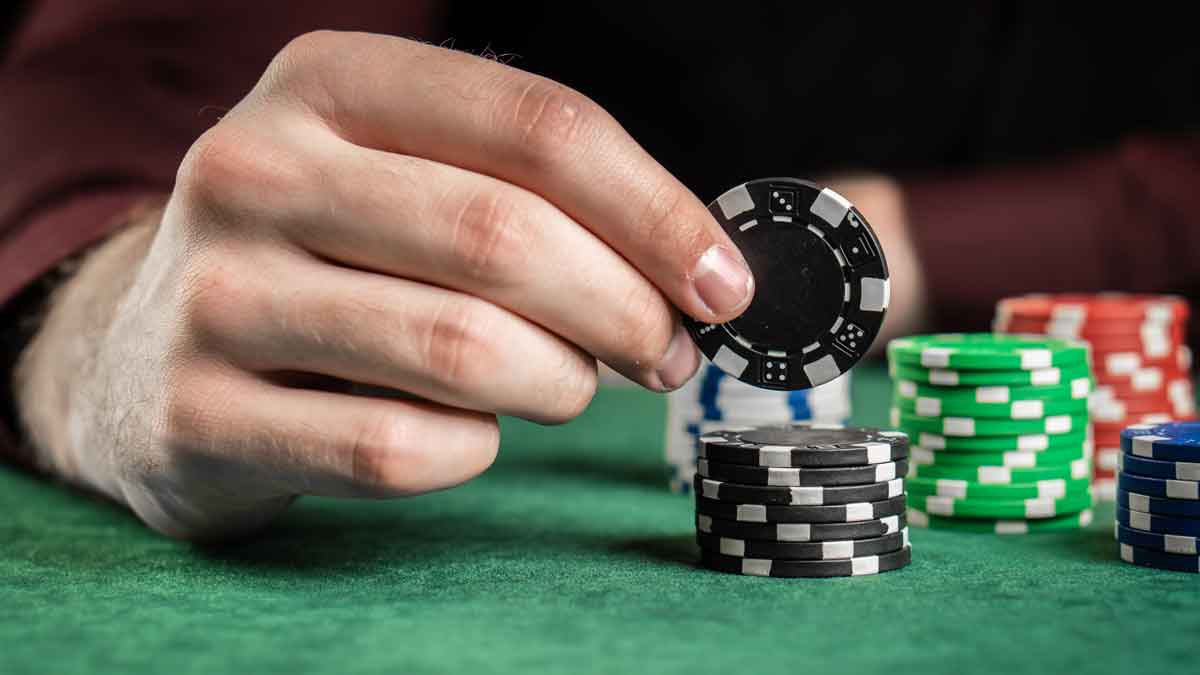 Knowing exactly how short you are in relation to the rest of the field is crucial. In his “Harrington on Hold’em” series, former WSOP Main Event winner Dan Harrington explains the concept of M. This is extremely useful to understand just how you stack up against the field.
Knowing exactly how short you are in relation to the rest of the field is crucial. In his “Harrington on Hold’em” series, former WSOP Main Event winner Dan Harrington explains the concept of M. This is extremely useful to understand just how you stack up against the field.
To calculate your M, simply divide your stack size by the total of the blinds and antes. If you have 1,000 in tournament chips and the blinds are 60/30 with no ante, your M is:
1000 / (60+30) = 11.11
But what does this figure mean? Let’s summarise quickly:
Green Zone: If your M is 20 or more, you are safe. You can play your normal game and shove-folding is not necessary.
Yellow Zone: An M of between 10 and 20 requires you to loosen up as things are becoming serious. But push-fold is not quite necessary yet.
Orange Zone: An M of between 6 and 10 means you’re in serious danger and it’s time to think about push-folding. You no longer have the capability of making advanced plays.
Red Zone: If your M is 5 or less, your only remaining play is all in. You’re almost certain to be called with an M of 3 or below
Push-Fold On The Bubble
The one time you should consider making an exception and leaving the push-fold in the locker is when the bubble is nearby. Naturally, you need a stronger justification for putting your tournament life at risk when you can almost taste the prize money.
If you can patiently wait for others to bust ahead of you, sneaking into the in-the-money level with your short stack is a real possibility. That’s where experienced poker players bring the Independent Chip Model (ICM) into play. But that’s an article for another time.
If you’re not familiar with ICM already, just know that you better have a good reason for shoving if you’re right on the bubble.
Push-Fold Charts
Having discussed how to use the push-fold strategy, let’s now take a look at the kind of hands you should be shoving with. The below charts are generated by ICMIZER, calculating the expected value when shoving in each situation.
We’ve generated push-fold ranges for various positions at the table when your stack is just 10 Big Blinds deep at a table of nine. But there’s also a second, revised chart for 15 BBs, where you have a little more breathing room. You’ll find them all displayed below.
UTG and UTG+1
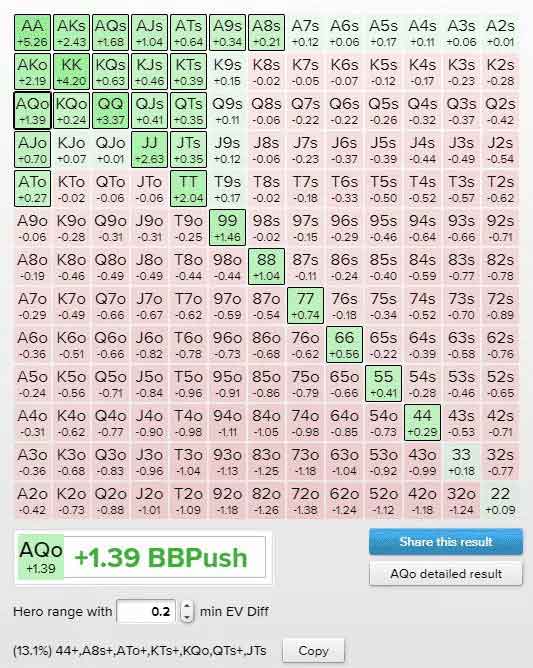 Since the push-fold ranges for Under The Gun (UTG) and Under The Gun + 1 are basically identical, we’ve combined them into a single chart. Any hand displayed in red is a negative EV shove, while the light green hands are marginally profitable.
Since the push-fold ranges for Under The Gun (UTG) and Under The Gun + 1 are basically identical, we’ve combined them into a single chart. Any hand displayed in red is a negative EV shove, while the light green hands are marginally profitable.
Those hands shown in bright green generate a theoretical profit of 20 BBs per 100 or more, which is a fantastic win rate. Therefore, these are automatic shoving hands with a stack of just 10 BBs.
 In this image, you’ll notice that the range for 15 BBs is not too dissimilar to that of the 10 BB chart. The mid-sized pocket pairs become more questionable shoves, while there’s no need at all to even consider a push with a rag Ace.
In this image, you’ll notice that the range for 15 BBs is not too dissimilar to that of the 10 BB chart. The mid-sized pocket pairs become more questionable shoves, while there’s no need at all to even consider a push with a rag Ace.
UTG+2 and Lojack Position
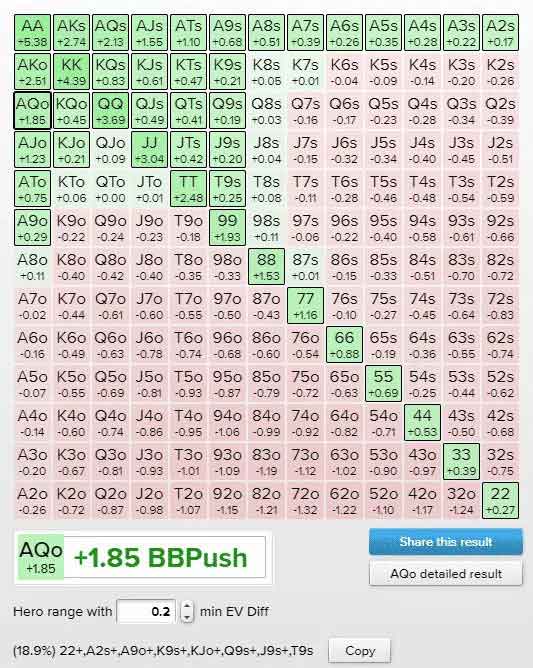 Your ideal shoving range when in the middle position is broadly similar to that of the earlier positions. However, with fewer players to act behind you, it’s possible to widen your selection slightly. So here the weak Aces come into play.
Your ideal shoving range when in the middle position is broadly similar to that of the earlier positions. However, with fewer players to act behind you, it’s possible to widen your selection slightly. So here the weak Aces come into play.
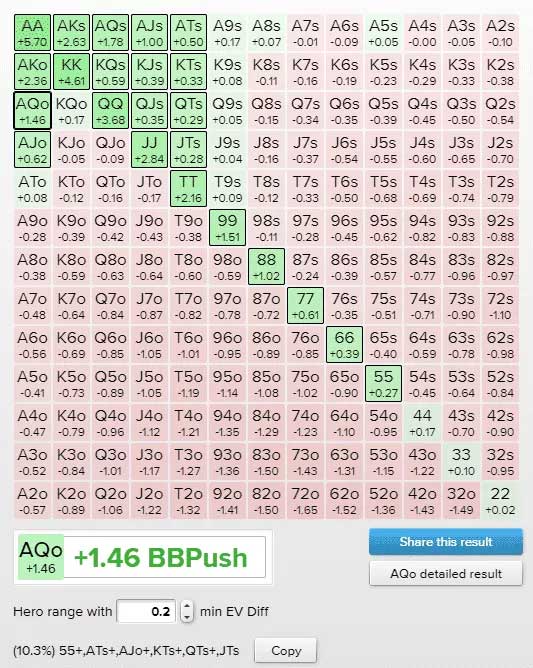 With 5 extra Big Blinds, you have enough of a cushion to tighten your shoving range slightly. Rag Aces become unprofitable all-in plays, while suited picture cards become much more questionable shoves.
With 5 extra Big Blinds, you have enough of a cushion to tighten your shoving range slightly. Rag Aces become unprofitable all-in plays, while suited picture cards become much more questionable shoves.
Hijack Position
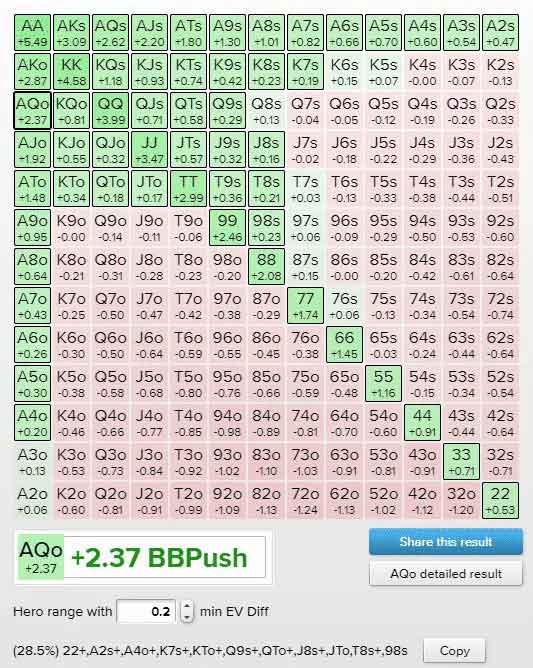 Due to your improved position, it’s easier to get a shove through. As such, you can profitably widen your range when playing from the Hijack spot. Medium-sized suited connectors and gappers start to become a factor, while all pocket pairs as massively profitable shoves.
Due to your improved position, it’s easier to get a shove through. As such, you can profitably widen your range when playing from the Hijack spot. Medium-sized suited connectors and gappers start to become a factor, while all pocket pairs as massively profitable shoves.
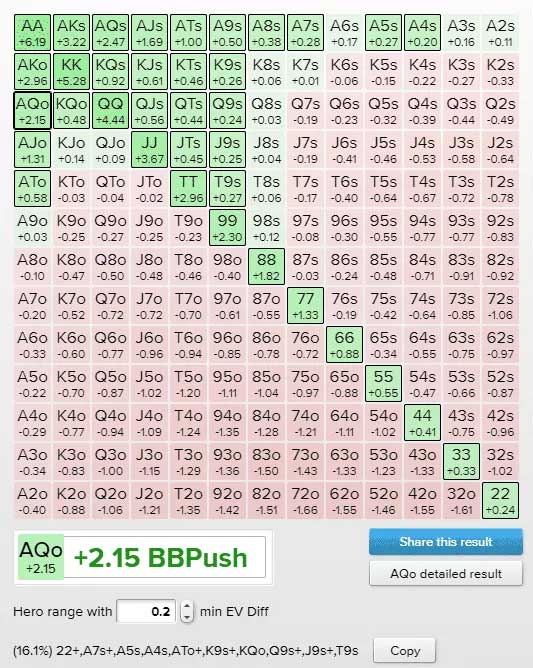 This chart is quite similar to the UTG+2 and Lojack chart for a 10 BB stack. Essentially, those few extra BBs in your stack give you extra time, so you can tighten up your shove range somewhat.
This chart is quite similar to the UTG+2 and Lojack chart for a 10 BB stack. Essentially, those few extra BBs in your stack give you extra time, so you can tighten up your shove range somewhat.
Button and Cut-Off
 At this point, you can reasonably push with almost 50% of your hands. Almost any Ace or King is good, suited or not, as are most suited connectors and gappers.
At this point, you can reasonably push with almost 50% of your hands. Almost any Ace or King is good, suited or not, as are most suited connectors and gappers.
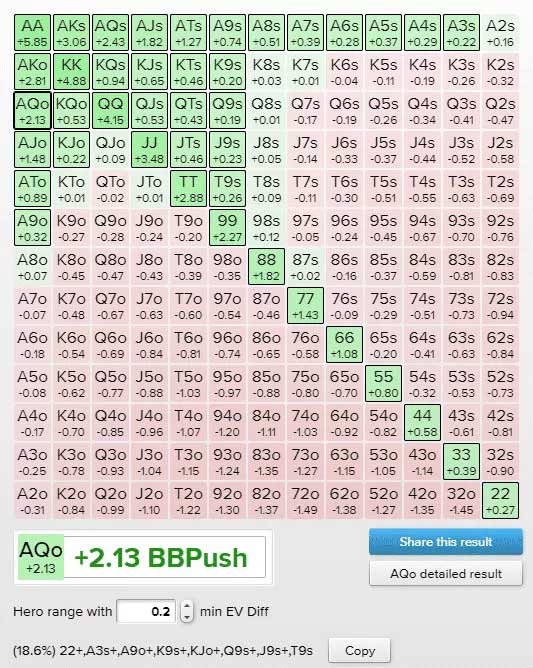 However, with an additional 5 BBs in your stack, things change quickly in late position. Even though it will be much easier to pick up the pot with a push, there’s no need for desperation at this point.
However, with an additional 5 BBs in your stack, things change quickly in late position. Even though it will be much easier to pick up the pot with a push, there’s no need for desperation at this point.
Small Blind
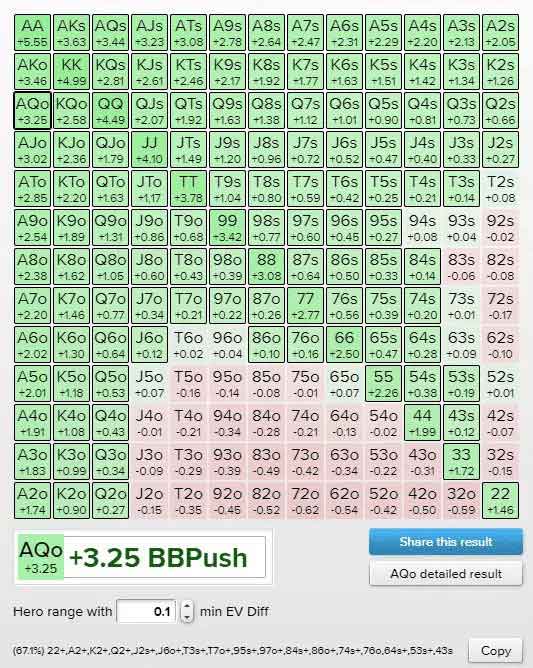 When you’re in the Small Blind, you’ll naturally have to commit a portion of your already tiny stack to the pot. So it’s a no-brainer to shove with almost all hands, in order to protect that investment and try to steal the Big Blind.
When you’re in the Small Blind, you’ll naturally have to commit a portion of your already tiny stack to the pot. So it’s a no-brainer to shove with almost all hands, in order to protect that investment and try to steal the Big Blind.
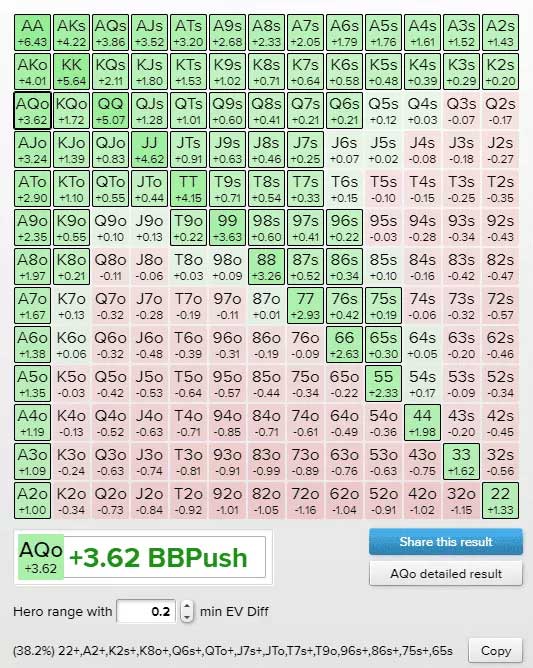 The logic is similar here in the 15 BB push-fold chart. But naturally, with the luxury of 5 extra BBs, there’s no need to panic quite yet. Your optimal range is quite similar to that of the Button range with just 10 BBs.
The logic is similar here in the 15 BB push-fold chart. But naturally, with the luxury of 5 extra BBs, there’s no need to panic quite yet. Your optimal range is quite similar to that of the Button range with just 10 BBs.
Conclusion
In short, the shove-fold strategy should be used when you are short-stacked in poker tournaments. It allows you to:
Preserve chips by avoiding limping or raising only to fold later in the hand
Get paid in full when winning a hand, doubling your chip stack
Steal precious blinds and antes to increase your chip count
The best way to learn is often through practice. So, why not sign up for a free account with Natural8 and practice using the freerolls?













